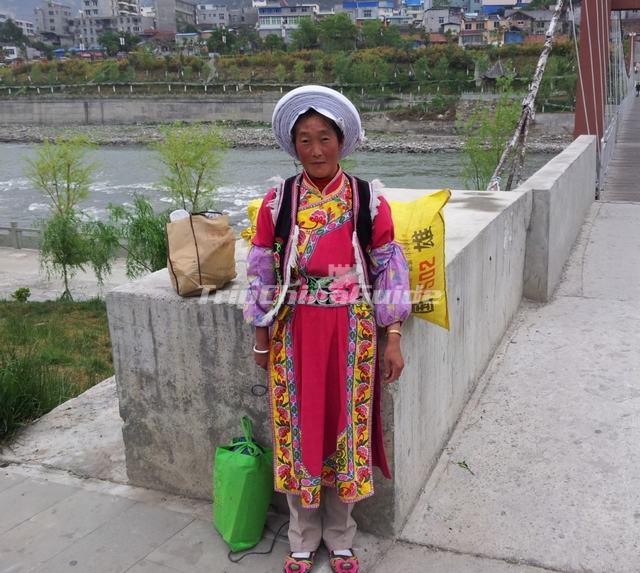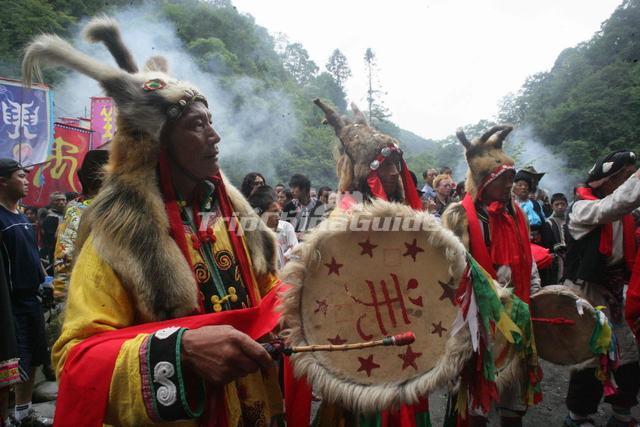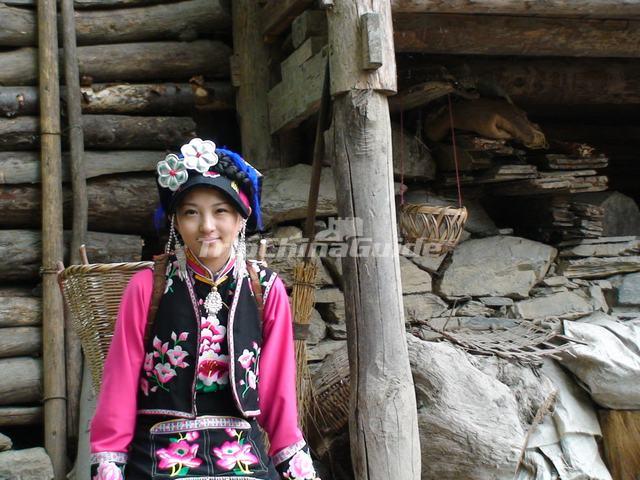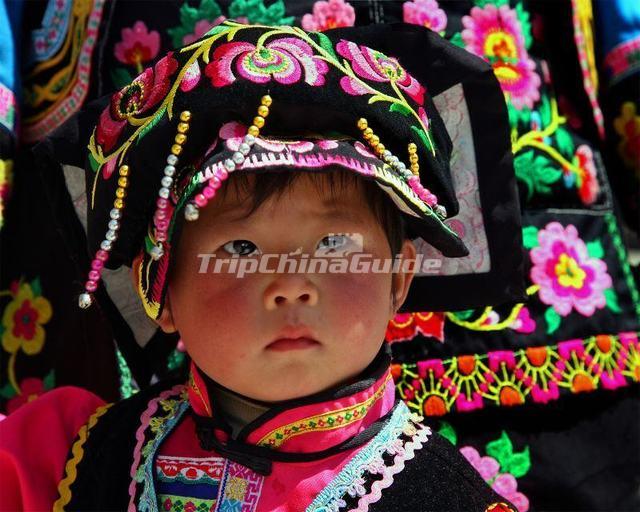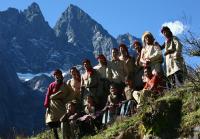Qiang Ethnic Group
China is a country of many nationalities. In the great Chinese family, the Qiang people are one of the most ancient nationalities. Oracle bone inscriptions from 3,000 years ago record that the Qiang people were living mainly in Northwest China and the Central Plains. Later, a branch of the nationality was incorporated into the Tibetan ethnic group, and another into the Han Nationality. The Qiang people today are the descendants of the ancient Qiang Nationality.
Population
320,000 (2012)
Main Areas Inhabited by Qiang
Lvyang County (Shaanxi); Mao County, Wenchuan County, Li County, Qiang Autonomous County, Songpan County, Heishui County, Jiuzhaigou County, Danba County, Dujiangyan, Ya'an County (Sichuan); Jiangkou County, Shiqian County (Guizhou); and some areas in western Sichuan and Yunnan provinces.
History
"Qiang" was a name given by ancient Hans to the nomadic people in west China. The Qiangs were not a single distinctive ethnic group then. According to historical records, a clan group made their homes in what is today's Sichuan Province.
The Han Dynasty (206 B.C.-A.D. 220) court in the 2nd century had set up an administrative prefecture for the area. During A.D. 600 to 900 when the Tibetan Regime gradually expanded its rule over the region, some Qiangs were assimilated by the Tibetans and others by the Hans, leaving a small number unassimilated. These developed into the distinctive ethnic group of today.
The Qiangs do not have a written script of their own. They speak a language belonging to the Tibetan-Myanmese language family of the Chinese-Tibetan system. Owing to their close contact with the Han people, many Qiang people speak Chinese, which is also the written form for this ethnic group.
The Qiang and Han peoples have had time-honored close political, economic and cultural ties. Administratively, Han courts from the Qin, Han, Sui and Tang dynasties down to the Ming Dynasty all had political units in the Qiang-occupied areas. In the early Qing Dynasty (1644-1911), the system of appointing local hereditary headmen by the central authority to rule over the Qiangs gave way to officials dispatched from the court. The central administrative system helped enhance the ties between the Qiang and Han ethnic groups. With their horses, medicinal herbs and other native produce, the Qiangs used to barter farm implements and daily necessities from the Hans. Mutual support and help stimulated the social and economic development of Qiang society.
For a long period before China’s national liberation in 1949, the Qiangs lived in primitive conditions marked by slash and burn farming. A feudal landlord economy dominated production. Landlords and rich peasants, who accounted for only 8 per cent of the population, were in possession of 43 per cent of the cultivated land. Poor peasants and hired farm hands, accounting for 43 per cent of the population, had only 16 per cent of the land. Many poor peasants lost their land due to heavy rent coupled with usury. They became hired laborers, wandering from place to place to make a living.
Religion
The Qiang people practice shamanism, animism, Tibetan Buddhism, Taoism and the local “White Stone Religion.” Worship for the latter takes place in an area defined with stones placed on roof tops and altars. This religion incorporates animism and shamanism with the worship of a pantheon of gods. The worship of heavenly gods is important. There are a number of myths about the creation of mankind through the union of a daughter of a heaven god and earthly monkey.
Shaman do healing, preside over ceremonies and recite texts while beating on a goatskin drum. Festivals and ceremonies often involve the invocation of spirits through the burning of juniper branches. These are performed while sitting around a campfire outdoors.
After death, bodies are kept around the house for a few days and mourned and then cremated. Children or people who died away from their homes were not mourned. Their bodies were thrown in a river. Under Chinese influence, burial has become more common.
Society
The Qiang ethnic group has strict rules separating males and females. There are specific seating orders, rituals and even sleeping arrangements for men and women. Men are responsible for plowing, transport and other heavy work and preside over spiritual duties. Women do most of the field work. Both sexes share in child rearing duties and household chores. There is a tradition of matriarchal customs in Qiang areas, with women handling domestic affairs and men handling foreign affairs.
Villages and clusters of villages tend to be grouped by clan or people that believe they have a common ancestor. Justice is carried out both by headmen and elders, selected on the basis of kin and hereditary class. There is a tradition of blood feuds in Qiang areas. Qiang customs and language have been nearly vanished, victims of modernization and a forced policy of assimilation.
Marriage and Families
Unions between men and women have traditionally been weak while those between siblings have been strong. Sometimes unions between siblings occurred. Households are often created on a sibling basis rather a husband and wife basis with siblings sharing in the child rearing chores rather than husband and wife.
Romantic love has traditionally been valued and people enjoyed a fair amount of sexual freedom. In the old days there was no marriage. Couples either shared a household or they didn’t. Over time a system of bride-service was adopted and rituals to sanctify this arrangement were adopted. Bride-services varied in length.
Sometimes Qiang were betrothed before they were even born and Qiang boys got married between the ages of six and seven. Qiang women have traditionally been much older than their husbands because they usually got married between the ages of 12 and 18. These marriage customs are dying out and many Qiang now don't get married until they are in their twenties.
"Mountain songs" are often sung for courtship purposes. They are often accompanied by circular dances that involved the exchange of songs between males and females. The mouth harp has traditionally been played by women to serenade their lovers. In some places men play a double-reed Qiang flute for the same purpose.
Ancient Qiang wedding rituals include dancing to traditional music, planting saplings to symbolize happiness and throwing corn and millet over the crowd for good fortune.
Building
The Qiang people built their homes from stone, earth and timber, judging all measurements by eye, rather than designing scientifically; yet all buildings have stood firm, straight and long. The Qiang houses usually have five stories.
Livestock is kept on the first floor, and the living room, bedrooms and kitchen are on the second and the third. The fourth is used for storage and the fifth is a place of worship where white stones are arranged upon which sacrifices are offered.
The living room on the second floor has a wooden floor, and several wooden pillars supporting the roof. The focal point of the living room is the fireplace, made from stone slabs, where a fire burns the whole year round. The fireplace is also where family and friends gather to celebrate weddings, births and festivals.
Clothing
Qiang people have a strong aesthetic sense, as can be seen from their daily dress and ornamentation. They sew their own garments and footwear and embroider them with various motifs. Women's wearing, from hats to shoes, is elaborately decorated with floral patterns, sometimes giving the impression that the scent of flowers emanates from the clothes.
Culture and Art
The Qiang people have created a unique culture and arts and crafts. The clever and deft Qiang women can do embroidery and drawnwork extemporaneously without designs. The Qiangs are good singers and dancers. "Wine song," "plate song," "mountain song" and "leather drum" dances with accompaniment of gongs, sheepskin drum,tambourines, sonas, Qiang flutes (a kind of Qiang ethnic style bamboo flute), and Kouxian (a kind of stringed instrument made of bamboo) are popular.
Festivals
The Qiang people’s New Year falls on the first day of the tenth lunar month. The celebrations are usually lasted three to five days, during which sacrifices are made to the god of the heavens, the god of the mountain and the god of the village.
Food
Qiang people like medicinal dishes, particularly soup, that have specific functions for body organs.
Taboos
Qiang households are not allowed to be visited when a family member is sick or a woman is pregnant. Stepping over the fireplace of the Qiang people is forbidden.
Recommended China Tour Packages
-
11-day Affordable China Tour for Students
-
5-day Chengdu Panda & Xiling Snow Mountain Ski Tour
-
10-day Yunnan-China Tea Horse Road Tour







